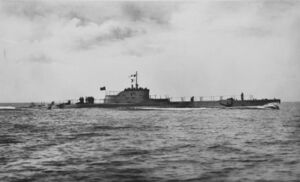Engineering:Pisani-class submarine
 Vettore Pisani on the surface
| |
| Class overview | |
|---|---|
| Operators: |
|
| Preceded by: | Mameli class |
| Succeeded by: | Bandiera class |
| In commission: | 1928–1947 |
| Completed: | 4 |
| Scrapped: | 4 |
| General characteristics | |
| Type: | Submarine |
| Displacement: | |
| Length: | 68.2 m (223 ft 9 in) |
| Beam: | 6.09 m (20 ft) |
| Draft: | 4.93 m (16 ft 2 in) |
| Installed power: | |
| Propulsion: |
|
| Speed: |
|
| Range: |
|
| Test depth: | 90 m (300 ft) |
| Crew: | 48 |
| Armament: |
|
The Pisani-class submarines were built for the Regia Marina (Royal Italian Navy) during the late 1920s. They played a minor role in the Spanish Civil War of 1936–1939 supporting the Spanish Nationalists.
Design and description
Designed in parallel with the Mameli-class submarines, the Pisani class was larger to accommodate more fuel and give them more range. They displaced 880 metric tons (866 long tons) surfaced and 1,057 metric tons (1,040 long tons) submerged. The submarines were 68.2 meters (223 ft 9 in) long, had a beam of 6.09 meters (20 ft) and a draft of 4.93 meters (16 ft 2 in).[1] They had an operational diving depth of 90 meters (300 ft).[2] Their crew numbered 48 officers and enlisted men.[1]
For surface running, the boats were powered by two 1,500-brake-horsepower (1,119 kW) diesel engines, each driving one propeller shaft. When submerged each propeller was driven by a 550-horsepower (410 kW) electric motor. Like the Mamelis, their stability was poor and they had to be modified with bulges after completion. This reduced their speeds from 17.25 knots (31.95 km/h; 19.85 mph) on the surface and 8.75 knots (16.21 km/h; 10.07 mph) underwater to 15 knots (28 km/h; 17 mph) and 8.2 knots (15.2 km/h; 9.4 mph) respectively. On the surface, the Pisani class had a range of 5,000 nautical miles (9,300 km; 5,800 mi) at 8 knots (15 km/h; 9.2 mph);[1] submerged, they had a range of 70 nmi (130 km; 81 mi) at 4 knots (7.4 km/h; 4.6 mph).[2]
The boats were armed with six 53.3-centimeter (21 in) torpedo tubes, four in the bow and two in the stern for which they carried a total of nine torpedoes. They were also armed with a single 102-millimeter (4 in) deck gun forward of the conning tower for combat on the surface. Their anti-aircraft armament consisted of two 13.2-millimeter (0.52 in) machine guns.[1]
Boats
| Ship | Builder[1] | Laid down[3] | Launched[3] | Completed[3] | Fate[3] |
|---|---|---|---|---|---|
| Giovanni Bausan | Cantiere Navale Triestino, Trieste | 27 January 1926 | 24 March 1927 | 15 September 1929 | Decommissioned 16 April 1942, converted into an oil barge |
| Marcantonio Colonna | 3 December 1925 | 26 December 1927 | 10 July 1929 | Scrapped, 1943 | |
| Des Geneys | 1 February 1926 | 14 November 1928 | 31 October 1929 | Decommissioned 16 April 1942, converted into a battery-charging hulk | |
| Vettor Pisani | 18 November 1925 | 24 November 1927 | 16 June 1929 | Decommissioned, 23 March 1947 |
Service history
During the Spanish Civil War, Vettore Pisani made at least one patrol off the Catalan coast in August 1937 during which she made one unsuccessful attack.[4]
Notes
- ↑ Jump up to: 1.0 1.1 1.2 1.3 1.4 Chesneau, p. 307
- ↑ Jump up to: 2.0 2.1 Bagnasco, p. 141
- ↑ Jump up to: 3.0 3.1 3.2 3.3 Fraccaroli, p. 127
- ↑ Frank, p. 96
References
- Bagnasco, Erminio (1977). Submarines of World War Two. Annapolis, Maryland: Naval Institute Press. ISBN 0-87021-962-6.
- Brescia, Maurizio (2012). Mussolini's Navy: A Reference Guide to the Regina Marina 1930–45. Annapolis, Maryland: Naval Institute Press. ISBN 978-1-59114-544-8.
- Chesneau, Roger, ed (1980). Conway's All the World's Fighting Ships 1922–1946. Greenwich, UK: Conway Maritime Press. ISBN 0-85177-146-7.
- Fraccaroli, Aldo (1968). Italian Warships of World War II. Shepperton, UK: Ian Allan. ISBN 0-7110-0002-6.
- Frank, Willard C. Jr. (1989). "Question 12/88". Warship International XXVI (1): 95–97. ISSN 0043-0374.
- Rohwer, Jürgen (2005). Chronology of the War at Sea 1939–1945: The Naval History of World War Two (Third Revised ed.). Annapolis, Maryland: Naval Institute Press. ISBN 1-59114-119-2.
External links
- Vettor Pisani Marina Militare website
 |


